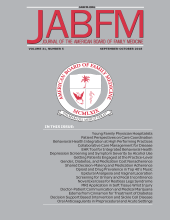Article Figures & Data
Tables
- Table 1. Demographics and Prevalence of Prior Family Violence and Bivariate Analyses Comparing Intimate Partner Violence (IPV) Perpetration and Nonperpetration Among Married or Cohabiting Adult Men (N = 530)
Variable Full sample (N = 530) No IPV Perpetration (n = 428) IPV perpetration (n = 102) IPV Perpetration, OR* (95% CI) Demographics Mean age, years (SD) 42.6 (13.1) 43.0 (13.4) 41.0 (11.8) 0.98 (0.96–1.00) Non-Hispanic white race 415 (78.3) 339 (79.2) 76 (74.5) 0.77 (0.46–1.27) Education beyond high school 298 (56.2) 248 (57.9) 50 (49) 0.70 (0.45–1.08) Health insurance 383 (72.3) 311 (72.7) 72 (70.6) 0.90 (0.56–1.45) Employed 444 (83.8) 358 (83.6) 86 (84.3) 1.05 (0.58–1.90) Mean income, in tens of thousands $ (SD) 7.7 (4.9) 7.9 (5.0) 7.2 (4.7) 0.97 (0.93–1.02) Health services use Regular doctor for routine care — 324 (75.7) 66 (64.7) 0.59 (0.37–0.93)† ≥1 Routine health visit in past year — 266 (62.1) 54 (52.9) 0.69 (0.44–1.06) ≥1 Emergency room visit in past year — 115 (26.9) 32 (31.1) 1.24 (0.78–1.99) Physical symptoms or health conditions Chronic pain from arthritis — 88 (20.6) 23 (22.5) 1.12 (0.67–1.89) Chronic back or neck pain — 130 (30.4) 31 (30.4) 1.00 (0.63–1.60) Chronic pain from other sources — 39 (9.1) 14 (13.7) 1.59 (0.83–3.05) Epilepsy or seizures — 9 (2.1) 1 (1.0) 0.46 (0.06–3.68) Injury or poisoning in past year — 42 (9.8) 10 (9.8) 1.00 (0.48–2.06) Irritable bowel syndrome symptoms — 18 (4.2) 12 (11.8) 3.04 (1.41–6.53)‡ Insomnia symptoms, mean (SD) — 1.98 (0.85) 2.25 (0.89) 1.42 (1.11–1.81)‡ Headache symptoms, mean (SD) — 1.78 (0.65) 1.89 (0.72) 1.27 (0.93–1.75) Mental health diagnoses, DSM-IV criteria Substance abuse/dependence§ — 96 (22.4) 39 (38.2) 2.14 (1.35–3.39)‡ Major depressive disorder — 78 (18.2) 19 (18.6) 1.03 (0.59–1.79) Posttraumatic stress disorder — 20 (4.67) 5 (5.0) 1.05 (0.39–2.87) Anxiety disorders‖ — 46 (10.7) 15 (14.0) 1.43 (0.76–2.68) Prior family violence Victim of childhood family violence¶ 234 (44.2) 170 (39.7) 64 (63.4) 2.63 (1.68–4.11)** Witnessed childhood family violence†† 97 (18.4) 62 (14.6) 35 (35) 3.16 (1.93–5.17)** Data are n (weighted %) unless otherwise indicated. IPV perpetration includes having pushed, grabbed, or shoved; threw something; slapped or hit; kicked, bit, or hit with a fist; beat up; choked; burned or scalded; and threatened their partner with a knife or gun.
↵* The odds ratio reference category is no IPV perpetration.
↵† P < .05.
↵‡ P < .01.
↵§ Alcohol abuse, alcohol dependence, drug abuse, or drug dependence.
↵‖ Panic disorder or generalized anxiety disorder.
↵¶ N = 529 because only 529 randomly assigned men received both the IPV perpetration and victim of childhood family violence questions.
↵** P < .001.
↵†† N = 526 because only 526 randomly assigned men received both the IPV perpetration and witnessed childhood family violence questions.
- Table 2. Multivariate Logistic Regression Showing Correlates of Any Intimate Partner Violence (IPV) Perpetration Among Adult Married and Cohabiting Men
Characteristics IPV Perpetration Model 1 (n = 530) Model 2 (n = 530) Model 3* (n = 526) Demographics Age, years (in decades) 1.00 (0.98–1.02) 1.00 (0.98–1.02)) 1.00 (0.98–1.02) Non-Hispanic white race vs. other 0.80 (0.48–1.35) 0.79 (0.47–1.34) 0.80 (0.46–1.37) Employed 1.19 (0.60–2.36) 1.20 (0.60–2.39) 1.09 (0.53–2.22) Education beyond high school 0.80 (0.50–1.29) 0.84 (0.52–1.36) 0.90 (0.55–1.49) Income, $ (in tens of thousands) 0.99 (0.94–1.05) 0.99 (0.94–1.05) 0.98 (0.93–1.03) Health services use Regular doctor for routine care 0.67 (0.41–1.09) 0.72 (0.43–1.18) 0.73 (0.44–1.23) Physical symptoms Irritable bowel syndrome symptoms 2.80 (1.26–6.21)† 2.61 (1.17–5.84)† 2.19 (0.95–5.01) Insomnia symptoms 1.38 (1.08–1.77)† 1.33 (1.04–1.71)† 1.29 (0.99–1.67) Mental health diagnoses, DSM-IV criteria Substance abuse/dependence‡ 1.76 (1.09–2.85)† 1.60 (0.97–2.66) Prior family violence Victim of childhood family violence 1.99 (1.21–3.28)§ Witnessed childhood family violence 2.02 (1.17–3.49)† Data are odds ratios (95% confidence intervals). No IPV perpetration is odds ratio reference category. IPV perpetration includes having pushed; grabbed or shoved; threw something; slapped or hit; kicked, bit, or hit with a fist; beat up; choked; burned or scalded; or threatened their partner with a knife or gun. Model 1 includes only demographics, health services use, and physical symptoms that primary care physicians routinely assess. Model2 added substance abuse and dependence to evaluate whether the associations with physical symptoms remained significant. Model 3 added prior family violence to understand the relationship of IPV to substance abuse and history of family violence.
↵* Model 3 cohort was n = 526 because only 526 randomly assigned men received both the IPV perpetration and prior family violence questions.
↵† P < .05.
↵‡ Alcohol abuse, alcohol dependence, drug abuse, or drug dependence.
↵§ P < .01.






